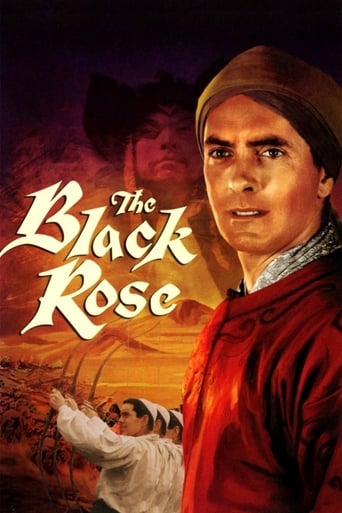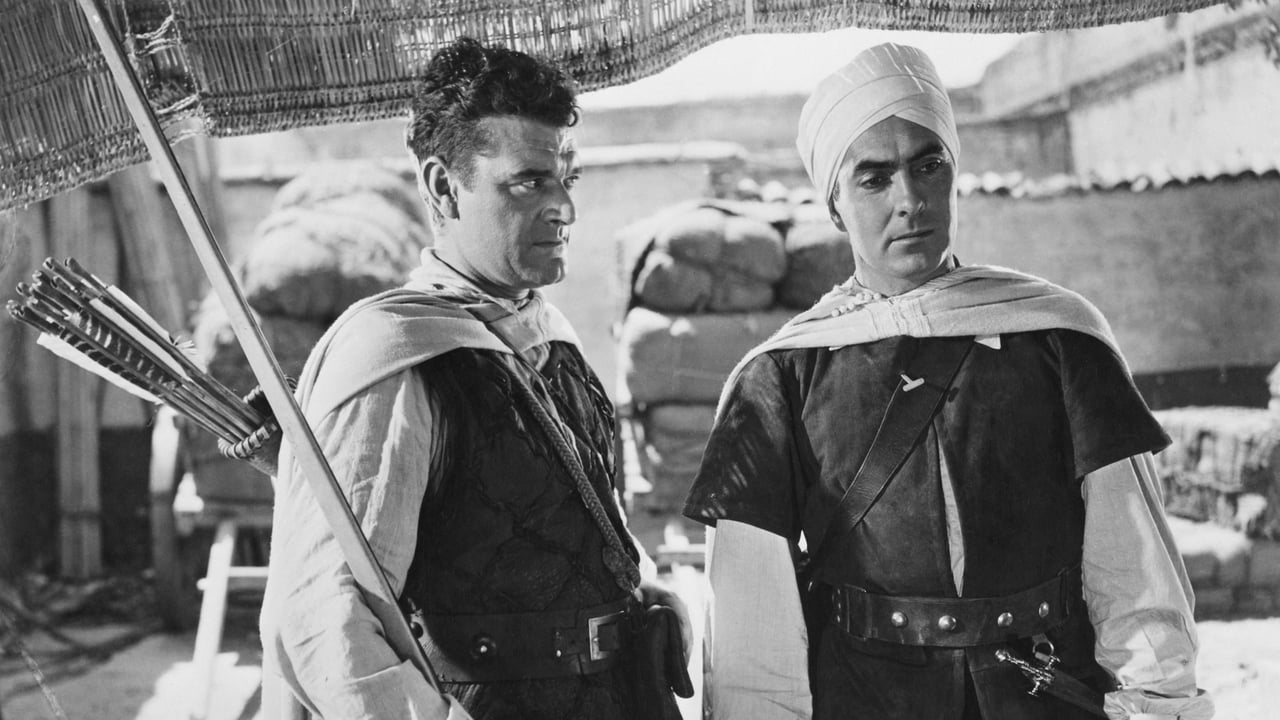JohnHowardReid
Narrated by Michael Rennie. Director: HENRY HATHAWAY. Screenplay: Talbot Jennings. Based on the novel by Thomas B. Costain. Technicolor photography: Jack Cardiff. Technicolor consultant: Joan Bridge. Music: Richard Addinsell. Music conductor: Muir Mathieson. Art directors: Paul Sheriff and W. Andrews. Film editor: Manuel Del Campo. Special effects: W. Percy Day. Costumes: Michael Whittaker. Sound: Buster Ambler. Western Electric Sound System. Made at London Film Studios, Shepperton, England, and on locations in North Africa. Producer: Louis D. Lighton. Copyright 24 August 1950 by 20th Century-Fox Film Corp. New York opening at the Roxy: 1 September 1950. U.S. release: 8 August 1950. U.K. release: 25 September 1950. Australian release: 8 September 1950. Sydney opening at the Regent. 10,910 feet. 120 minutes.
SYNOPSIS: Two 13th century Saxons, with a hatred for the Normans, leave England for China where they team up with a vicious Mongol warlord. NOTES: Negative cost: $4.5 million. Number 14 at Australian ticket windows for 1950, the film was also one of the top 25 attractions at the U.S./Canadian box office for the year. In the United Kingdom, however, where both Power and Hawkins were major money-spinning stars, the film failed to place among the champions. Michael Whittaker was nominated for an Academy Award for his color costume designs, losing to Samson and Delilah. Final film of Cecile Aubry, the star of Manon. I'm told she retired from the screen after marrying a Moroccan prince who met her whilst visiting the film set. VIEWERS' GUIDE: Extraordinarily, the current film censor's classification is "G" for general exhibition. You'd think the movie would at least rate a "PG" for occasional medium-level violence. I would go further. Adults only. It's not just that the violence is occasional, it's the way it's presented. The movie is permeated with a vicious tone of casual cruelty which makes the violence seem even more forceful than what is actually depicted. INITIAL COMMENT: In many ways, a typical Hathaway film with exciting action episodes and effective use of natural backgrounds. The plot has a Boys Own Paper quality but it is more literate in the telling than it is in the synopsis and the characters are vividly brought to life by a fine cast of seasoned players. Hathaway feels that he was unsuccessful with Welles and Aubry but to my mind Welles has a compelling screen presence even when he is not trying as here. Aubry makes a charming and unusual Hollywood heroine in that she has a strong personality that belies her youthful appearance. The only colorless player is Mr. Power who gives his usual efficient but unremarkable performance. The film has been lensed on a lavish budget, the sets and the color photography are never less than breathtaking." UPDATED COMMENT: Alas, my initial enthusiasm was not borne out by a current viewing. True, a viewing on TV, and you just can't hope to match the impact of a movie designed for the cinema screen when that picture is reduced to lounge-room dimensions and shown to an audience of two. All the same it's curious that I now find myself in agreement with my contemporary colleagues.
MARIO GAUCI
I know this was shown on Italian TV during my childhood but I'm not sure whether I had watched the film in its entirety - after this viewing, I certainly didn't recollect much of anything and, therefore, consider it as a first!Anyway, I decided to catch up with it now as an accompaniment to star Tyrone Power's most popular vehicle - THE MARK OF ZORRO (1940). Unlike that one (shot in black-and-white on studio sets), however, this was splashed with color and had the benefit of location photography: still, it's a much inferior spectacle, and the main reason for this is that the plot itself singularly lacks excitement - despite being basically an amalgam of Ivanhoe (starting off in medieval England with our Saxon hero opposing the Norman rulers) and Marco Polo (he eventually travels to the Orient and brings back samples of their exotic heritage). Also, despite the imposing presence of Orson Welles as a fearsome but noble Mongol warrior, there's precious little action in this two-hour film (though it's never actually boring)!Despite the Fox banner, this was a British-based production and, consequently, the supporting cast and technical credits are nothing to sneeze at - the former including such stalwarts as Jack Hawkins (an unlikely but amiable bowman and Power's sidekick), Michael Rennie, Finlay Currie (as Power's proud and cantankerous grandfather), Herbert Lom, James Robertson Justice and Laurence Harvey (impossibly young as a Norman prince), as well as Alfonso Bedoya (whose voice was allegedly dubbed by Peter Sellers!) and child actor Robert Blake; behind the camera were such talents as legendary cinematographer Jack Cardiff, composer Richard Addinsell and production designer Paul Sheriff. The weakest link in the film is clearly leading lady Cecile Aubry, who struggles too hard to be winsome but results only in being irritating most of the time (not surprisingly, her career wasn't a long-lasting one).While certainly watchable and generally entertaining in itself, Power was better served by some of his other historical epics (among them the film that directly preceded it, PRINCE OF FOXES [1949], another - though more modest - collaboration with Orson Welles).
Rob Muir (gazelam)
Having seen this a number of times as a late-night or Saturday-afternoon movie growing up, I caught it again yesterday on television, and was pleasantly surprised. As other posters have commented on it's faithfulness to the book or as a historical setting, I won't comment on that.Probably due to an excellent cast, the movie manages to transcend many of the (at least now accepted) clichés and is very successful. Having Welles and Powers in leading roles obviously allows them to sell the story line in a very convincing manner. I am a big fan of swashbuckler movies, but this goes beyond the bravado with good character development. The large-scale shots were magnificent. Lots of extras, animals, etc. I was drawn into the story and quite dazzled by the cinematography.Although there is nothing profound here, this is an easy film to enjoy.
Neil Doyle
Thomas B. Costain gave us CAPTAIN FROM CASTILLE, a much better historical romance than his THE BLACK ROSE, and Fox has spared no expense in bringing this version of his novel to the screen. It's handsomely photographed by Jack Cardiff in England and North Africa as it spins the tale of two Saxons (TYRONE POWER and JACK HAWKINS) who join a tribal war party enroute to meeting a Tartan general in the Far East (ORSON WELLES, in swarthy make-up), during a period in the 13th century of great unrest between Normans and Saxons.The plot thickens once they reach the Orient where a girl known as The Black Rose (CECILE AUBRY) is hiding out and needs rescuing from Power and Hawkins. All of the desert scenes are filmed in Morocco to great effect, but the script never allows any of the characters to come alive. Power struggles manfully with a part that seldom allows him to swing into action, while Jack Hawkins (as a skilled bowman who can hit his targets accurately) has a little more to do than Power and does it well. He's particularly effective in a scene involving his marksmanship while the Tartan general watches, the penalty for losing being losing his head.But all the other events provide nothing but the eye candy of seeing Tyrone Power and his fellow players wearing colorful costumes. As an action adventure, this one fails to deliver the goods and there is a less than robust background score by Richard Addinsell.Trivia note: Power does not even attempt a British accent while Hawkins, of course, already has one. Cecil Aubry should have been dubbed or replaced by someone who could be understood.Summing up: Too much talk, too little action for an historical romance of this kind.



 AD
AD

